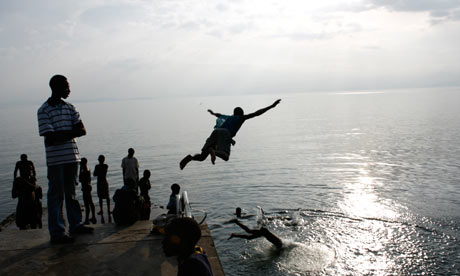Poisonous gas from Lake Kivu poses threat to millions
Trapped methane and carbon dioxide could be set loose by a quake or landslide, say scientists

Youngsters dive into the waters of Lake Kivu at Kisegi. Photograph: Kim Lundbrook/Corbis
More than two million people living on the banks of Lake Kivu in central Africa are at risk of being asphyxiated by gases building up beneath its surface, scientists have warned.
It is estimated that the lake, which straddles the borders of the Democratic Republic of Congo and Rwanda, now contains 300 cubic kilometres of carbon dioxide and 60 cubic kilometres of methane that have bubbled into the Kivu from volcanic vents. The gases are trapped in layers 80 metres below the lake's surface by the intense water pressures there. However, researchers have warned that geological or volcanic events could disturb these waters and release the gases.
The impact would be devastating, as was demonstrated on 21 August 1986 at Lake Nyos in Cameroon, in West Africa. Its waters were saturated with carbon dioxide and a major disturbance - most probably a landslide - caused a huge cloud of carbon dioxide to bubble up from its depths and to pour down the valleys that lead from the crater lake.
Carbon dioxide is denser than air, so that the 50mph cloud hugged the ground and smothered everything in its path. Some 1,700 people were suffocated.
full articlesitfu.com
Taking a Closer Look at the Stories Ignored by the Mainstream Media


0 Comments:
Post a Comment